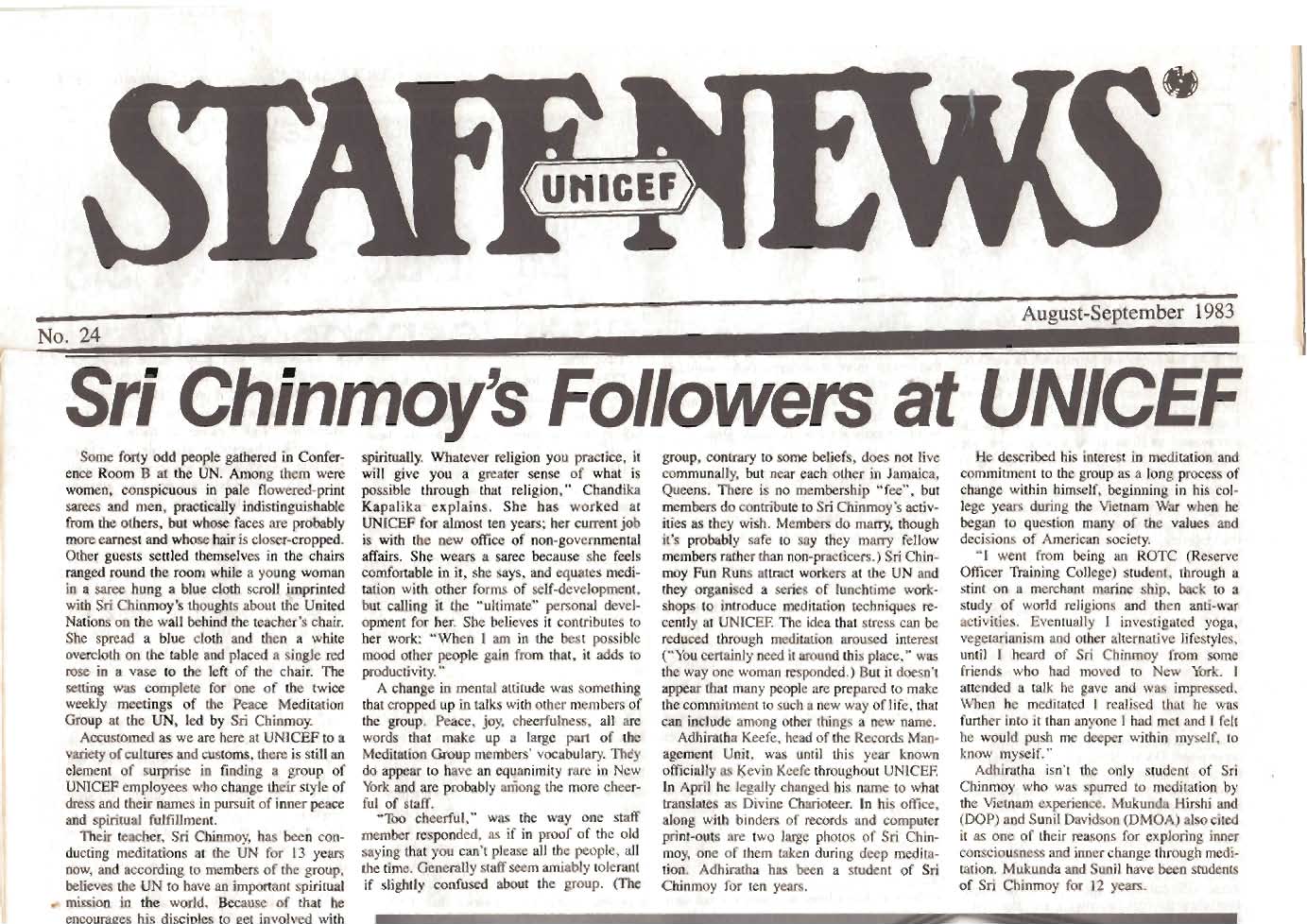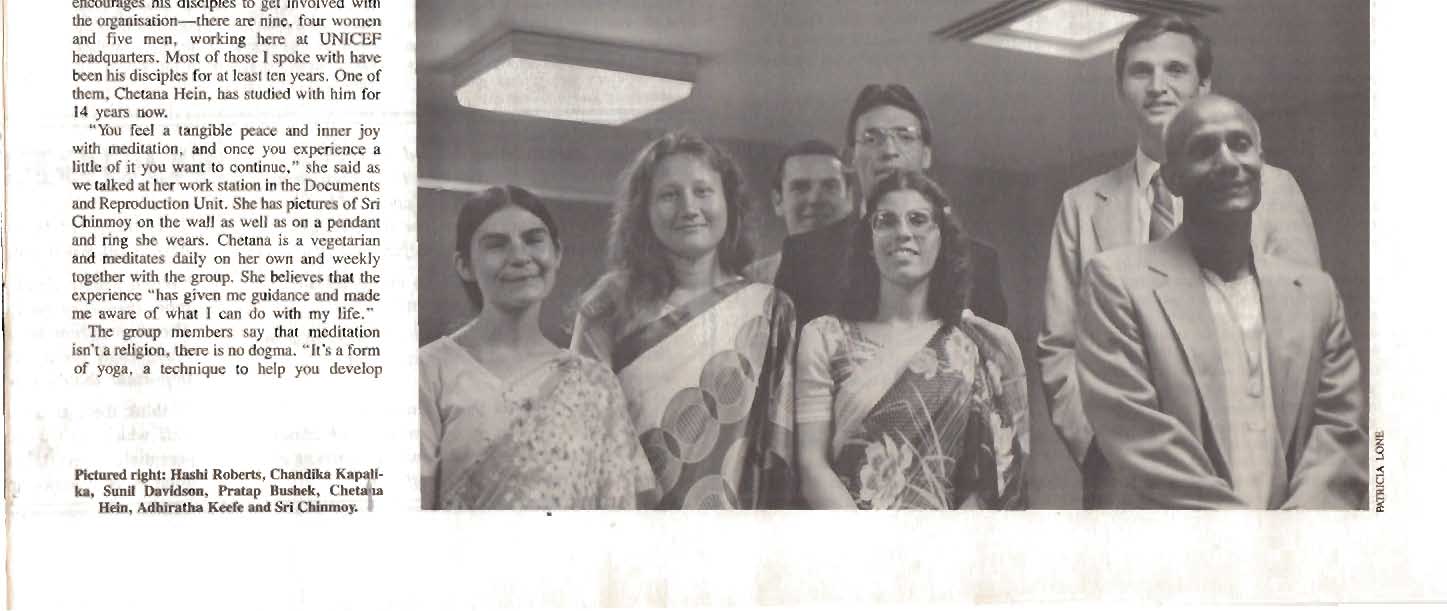Sri Chnmoy’s Followers at UNICEF – Staff News, Aug-Sep 1983
Filed under media coverage Text & Photos | Tributes and Expressions of appreciation
 Some forty odd people gathered in Conference Room B at the UN. Among them were women, conspicuous in pale flowered-print sarees and men, practically indistinguishable from the others, but whose faces are probably more earnest and whose hair is closer-cropped. Other guests settled themselves in the chairs ranged round the room while a young woman in a saree hung a blue cloth scroll imprinted with Sri Chinmoy’s thoughts about the United Nations on the wall behind the teacher ‘s chair. She spread a blue cloth and then a white overcloth on the table and placed a single red rose in a vase to the left of the chair. The setting was complete for one of the twice weekly meetings of the Peace Meditation Group at the UN, led by Sri Chimnoy.
Some forty odd people gathered in Conference Room B at the UN. Among them were women, conspicuous in pale flowered-print sarees and men, practically indistinguishable from the others, but whose faces are probably more earnest and whose hair is closer-cropped. Other guests settled themselves in the chairs ranged round the room while a young woman in a saree hung a blue cloth scroll imprinted with Sri Chinmoy’s thoughts about the United Nations on the wall behind the teacher ‘s chair. She spread a blue cloth and then a white overcloth on the table and placed a single red rose in a vase to the left of the chair. The setting was complete for one of the twice weekly meetings of the Peace Meditation Group at the UN, led by Sri Chimnoy.
Accustomed as we are here at UNICEF to a variety of cultures and customs, there is still an element of surprise in finding a group of UNICEF employees who change their style of dress and their names in pursuit of inner peace and spiritual fulfillment. Their teacher, Sri Chinmoy, has been conducting meditations at the UN for 13 years now, and according to members of the group, believes the UN to have an important spiritual mission in the world. Because of that he encourages his disciples to get involved with the organisation – there are nine, four women and five men, working here at UNICEF headquarters .
Most of those I spoke with have been his disciples for at least ten years. One of them, Chetana Hein, has studied with him for 14 years now. “You feel a tangible peace and inner joy with meditation, and once you experience a little of it you want to continue,” shc said as we talked at her work station in the Documents and Reproduction Unit. She has pictures of Sri Chinmoy on the wall as well as on a pendant and ring she wears . Chetana is a vegetarian and meditates daily on her own and weekly together with the group. She believes that the experience “has given me guidance and made me aware of what I can do with my life.”
The group members say that meditation isn’t a religion, there is no dogma. “It’s a form of yoga, a technique to help you develop spiritually. Whatever religion you practice, it will give you a greater sense of what is possible through that religion,”Chandika Kapalika expains. She has worked at UNICEF for almost ten years; her current job is with the new office of non-governmental affairs. She wears a saree because she feels comfortable in it, she says, and equates meditation with other forms of self-development, but calling it the ” ultimate” personal development for her. She believes it contributes to her work: “When I am in the best possible mood other people gain from that, it adds to productivity. “
A change in mental attitude was something that cropped up in talks with other members of the group. Peace, joy, cheerfulness, all are words that make up a large part of the Meditation Group members’ vocabulary. They do appear to have an equanimity rare in New York and are probably among the more cheerful of staff. “Too cheerful,” was the way one staff member responded, as if in proof of the old saying that you can’t please all the people, all the time. Generally staff seem amiably tolerant if slightly confused about the group. (The group, contrary to some beliefs, does not live communally, but near each other in Jamaica, Queens. There is no membership “fee”, but members do contribute to Sri Chinmoy’s activities as they wish. Members do marry, though it’s probably safe to say they marry fellow members rather than non-practicers.)
Sri Chinmoy Fun Runs attract workers at the UN and they organised a series of lunchtime workshops to introduce meditation techniques recently at UNICEF. The idea that stress can be reduced through meditation aroused interest (“You certainly need it around this place,” was the way one woman responded .) But it doesn’t appear that many people are prepared to make the commitment to such a new way of life, that can include among other things a new name.
Adhiratha Keefe, head of the Records Management Unit, was until this year known officially as Kevin Keefe throughout UNICEF. In April he legally changed his name to what translates as Divine Charioteer. In his office, along with binders of records and computer print-outs are two large photos of Sri Chinmoy, one of them taken during deep meditation. Adhiratha has been a student of Sri Chinmoy for ten years. He described his interest in meditation and commitment to the group as a long process of change within himself, beginning in his college years during the Vietnam War when he began to question many of the values and decisions of American society. “I went from being an ROTC (Reserve Officer Training College) student, through a stint on a merchant marine ship, back to a study of world religions and then anti-war activities. Eventually I investigated yoga, vegetarianism and other alternative lifestyles, until I heard of Sri Chinmoy from some friends who had moved to New York. I attended a talk he gave and was impressed. When he meditated I realised that he was further into it than anyone I had met and I felt he would push me deeper within myself, to know myself. “
Adhiratha isn’t the only student of Sri Chinmoy who was spurrcd to meditation by the Vietnam experience . Mukunda Hirshi (DOP) and Sunil Davidson (DMOA) also cited it as one of their reasons for exploring inner consciousness and inner change through meditation. Mukunda and Sunil have been students of Sri Chinmoy for 12 years.
Pictured right: Hashi Roberts, Chandika Kapalika, Sunil Davidson, Pratap Bushek, Chetana Hein, Adhiratha Keefe and Sri Chinmoy.